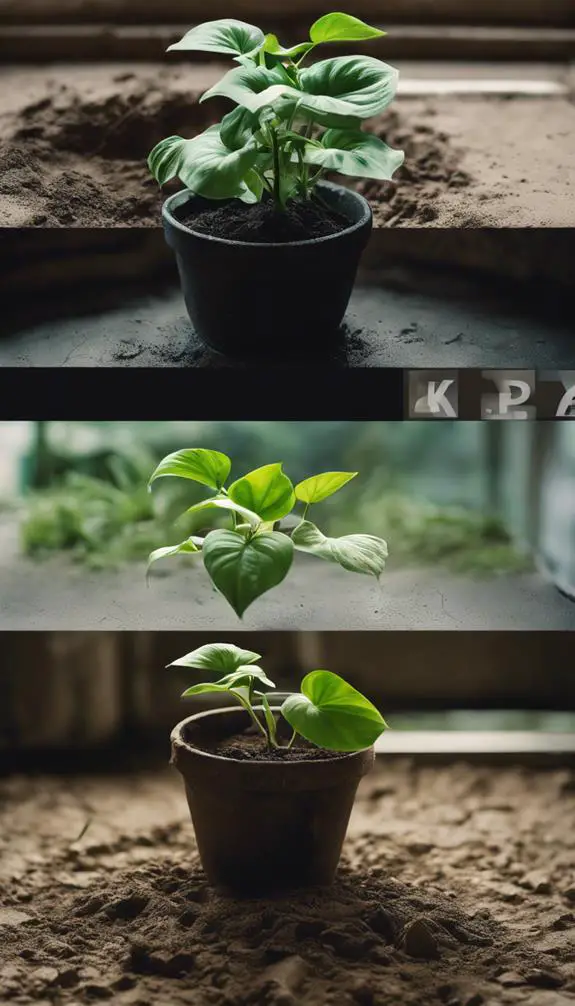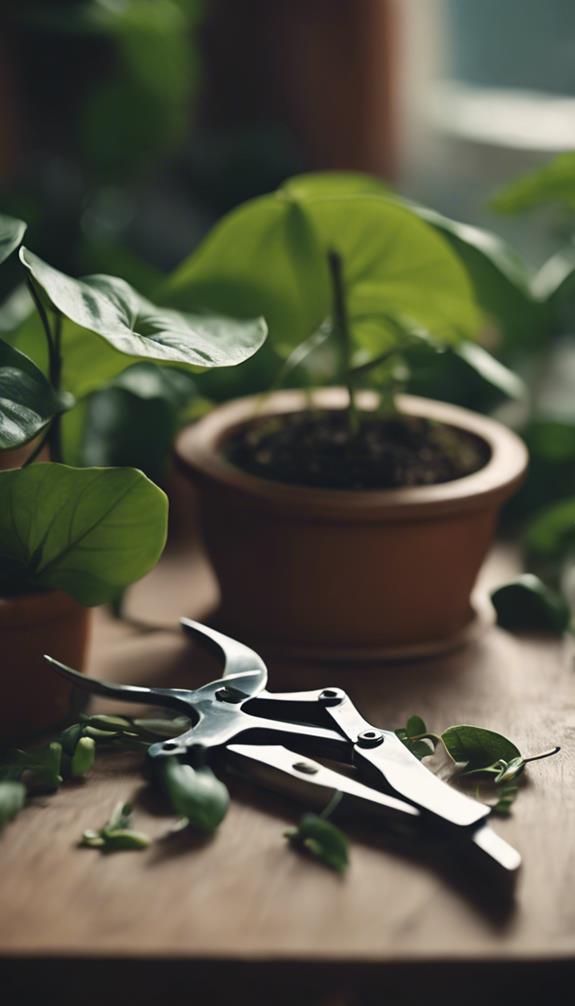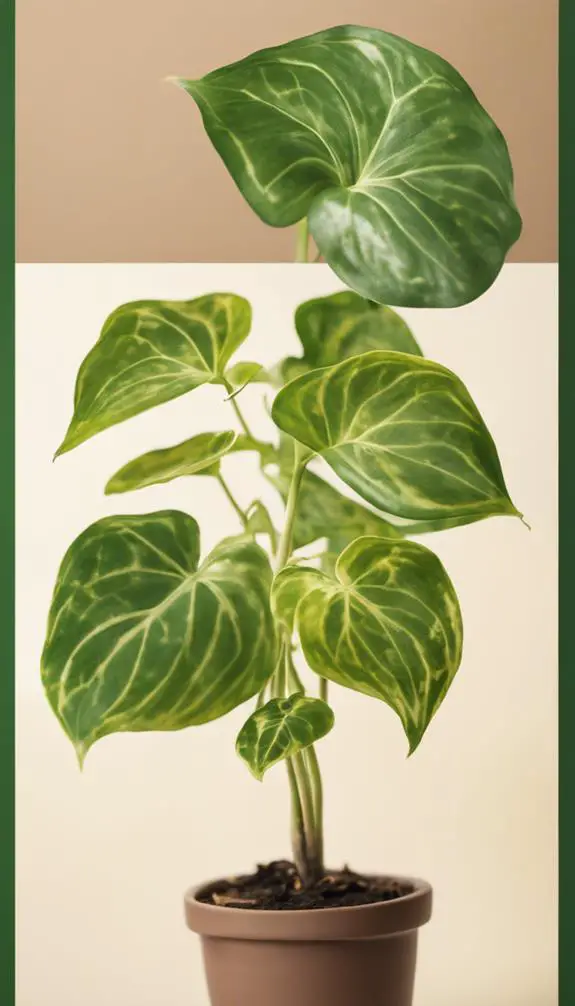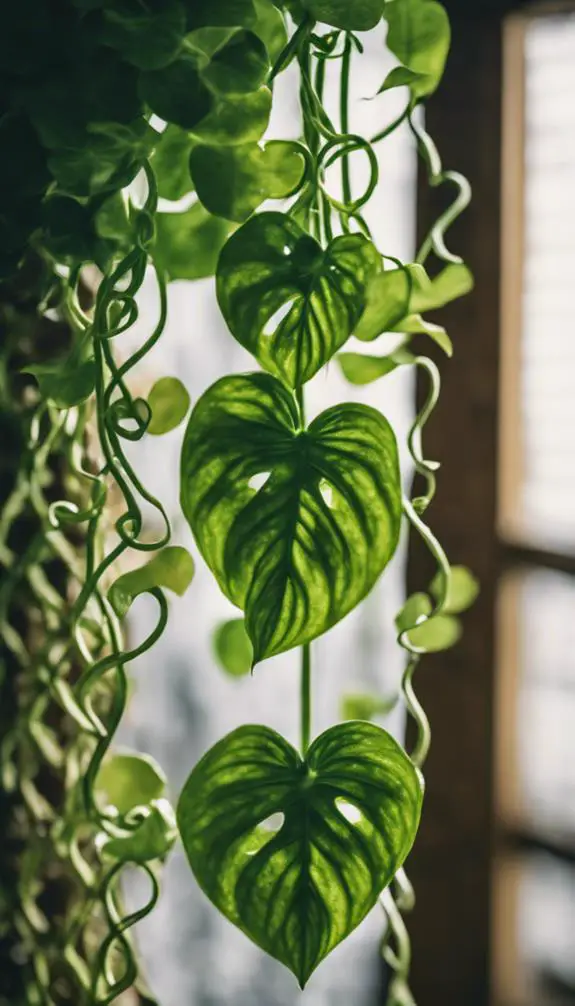You've brought home your new pothos plant, and now it's time to give it the care it needs to thrive. But where do you start? You've heard that pothos plants are low-maintenance, but you're not sure what that really means regarding lighting, watering, and fertilizing. You want to keep your plant happy and healthy, but you're worried about making mistakes that could lead to pests, diseases, or worse. Don't worry – with the right guidance, you can become a pothos pro and enjoy the many benefits of having this beautiful plant in your space.
Summary
- Provide bright, indirect light for pothos plants, maintaining a 10-15 feet distance from the light source for peak growth.
- Water pothos plants correctly by checking soil moisture and avoiding overwatering, which can lead to root rot and other issues.
- Maintain a temperature range of 65°F to 75°F (18°C to 24°C) and consistent humidity levels of 50-70% for ideal growth.
- Fertilize pothos plants with a balanced, water-soluble fertilizer and repot every one to two years to refresh the soil and provide a larger root system.
- Prune long vines back to encourage branching, remove dead leaves to maintain health and appearance, and shape the plant for dense growth.
Lighting Requirements for Pothos

When it comes to pothos plant care, understanding the lighting requirements is crucial for ideal growth and development.
You'll want to provide your pothos with bright, indirect light, but not direct sunlight, which can cause scorching. East- or west-facing windows are ideal for this.
If you can't provide bright lighting, don't worry – pothos can thrive in low light conditions too. However, be aware that low light may lead to slower growth and less vibrant colors.
Aim for 10-15 feet of distance between your pothos and the light source to guarantee peak growth. By balancing light intensity, you'll be rewarded with a lush, thriving pothos that'll purify the air and enhance your space.
Watering Tips and Tricks

You'll need to water your pothos correctly to keep it healthy and thriving. Overwatering can be detrimental, so verifying a water schedule that suits your plant's needs is crucial.
Check the soil moisture by sticking your finger into the soil up to the first knuckle. If the soil feels dry, it's time to water. You can also use water meters to measure the moisture levels accurately. Water your pothos when the meter reads between 1-3, indicating moderate moisture.
Avoid getting water on the leaves to prevent fungal diseases. Instead, water at the soil level, allowing the plant to absorb the water as needed. By following this schedule, you'll guarantee your pothos receives the right amount of water to stay healthy and flourish.
Humidity Needs and Control

Since pothos plants thrive in tropical environments, maintaining ideal humidity levels is essential to their survival.
You'll want to aim for a relative humidity of 50-70% to replicate their natural habitat. To achieve this, consider investing in humidifier options, such as ultrasonic or evaporative humidifiers, which can increase moisture levels without over-humidifying.
Ideal environments for pothos plants feature consistent humidity, which promotes healthy growth and prevents leaf curl. If you live in a dry climate, you may need to take extra measures to maintain perfect humidity.
Regularly misting your plant with a water spray bottle can also help supplement humidity levels. By controlling humidity, you'll create a thriving environment for your pothos plant to flourish.
Temperature Ranges for Optimal Growth

Pothos plants respond favorably to temperatures that mirror their native tropical environment, where warmth and consistency reign.
You'll want to maintain a temperature range of 65°F to 75°F (18°C to 24°C) for ideal growth, as this allows for healthy development and vibrant foliage.
Avoid temperature fluctuations, as they can cause stress to your plant.
While pothos plants have a moderate cold tolerance, temperatures below 55°F (13°C) can lead to damage or even death.
If you live in an area with cold winters, keep your pothos plant away from drafty windows and doors to prevent exposure to harsh temperatures.
Fertilizing Your Pothos Plant

Fertilizing your pothos plant is a crucial step in promoting healthy growth and development.
You can use foliar sprays, which are nutrient-rich liquids applied directly to the leaves, to provide essential micronutrients. This method is especially beneficial for plants grown in poor soil or those that are experiencing nutrient deficiencies.
Soil enhancers, on the other hand, are added to the soil to improve its fertility and structure. These can include organic matter like compost or manure, or synthetic fertilizers specifically formulated for indoor plants.
When choosing a fertilizer, opt for a balanced, water-soluble formula that's easy to absorb. Avoid over-fertilizing, as this can cause more harm than good. Stick to the recommended dosage and frequency to guarantee your pothos plant receives the nutrients it needs to thrive.
Soil Quality and Repotting

Your pothos plant's soil is its foundation, and using a high-quality potting mix is essential for its overall health.
Look for a mix that's specifically designed for tropical plants like pothos, as it'll retain moisture but drain excess water. Aim for a soil pH between 6.0 and 7.0, as pothos plants thrive in slightly acidic to neutral soil.
When repotting, choose a pot that's only one to two sizes larger than the current one to prevent the soil from becoming too wet.
Use a well-draining potting mix and gently remove the plant from its pot, taking care not to disturb the roots.
Repot your pothos plant every one to two years to refresh the soil and provide a larger root system. This will give your plant the best chance to flourish.
Pruning and Shaping Techniques

You'll want to prune long vines back to encourage branching and prevent your pothos from becoming leggy.
By shaping your plant for dense growth, you'll create a fuller, more attractive display.
Regularly removing dead leaves will also help maintain your plant's overall health and appearance.
Prune Long Vines Back
As your pothos plant grows, its vines can become leggy and unruly, overwhelming its container or surrounding decor.
To maintain a balanced appearance and promote healthy growth, you'll need to prune long vines back. This vine management technique involves cutting back the longest vines to about 6-8 inches from the node, where a leaf meets the stem.
Shape for Dense Growth
Three key pruning techniques can help shape your pothos plant for dense growth: pinching, notching, and topping.
When you pinch, you're removing the growing tip to encourage branching, which will lead to a fuller plant. Notching involves making a small cut on the stem just above a node, which prompts the plant to grow new shoots from that point.
Topping, on the other hand, involves cutting the stem about an inch above a node, which stimulates new growth and helps control the plant's height.
Remove Dead Leaves
By pruning your pothos plant to promote dense growth, you've likely encouraged a profusion of new leaves and stems.
However, this process can also reveal dead or dying leaves that need to be removed. Inspect your plant carefully, and pinch or cut off any dead or wilted leaves to prevent leaf decay.
This will help prevent the spread of disease and encourage healthy growth. Dispose of the removed leaves properly to prevent any potential pests or diseases from spreading.
Regularly removing dead leaves will also improve air circulation and reduce moisture around the plant, creating a healthier environment for your pothos to thrive.
Propagation Methods Explained

Get ready to multiply your pothos plant collection by mastering the art of propagation.
You'll be amazed at how easily you can create new plants from stem cuttings. Simply snip off a healthy stem section, making sure each cutting has at least two leaf nodules – the small, swollen areas on the stem where leaves meet.
Remove lower leaves, leaving only two or three at the top. Place the cut end in a glass of water or a propagation tray filled with a well-draining medium.
Roots will develop within a few weeks. Once roots are established, transfer the new plant to a pot filled with a balanced potting mix.
With a little patience, you'll have a thriving new pothos plant to add to your collection.
Pest Control and Common Pests

You'll need to regularly inspect your pothos plant for signs of infestation, as pests can quickly spread and cause significant damage.
Check for tiny eggs, white powdery residue, or actual pests on the leaves, stems, and soil. By catching infestations early, you can effectively use natural pest remedies, such as neem oil or insecticidal soap, to eliminate the problem before it gets out of hand.
Inspecting for Infestations
One of the most critical aspects of pothos plant care is regularly inspecting your plants for signs of infestation.
You'll want to perform a thorough pest inspection every 1-2 weeks to catch any issues early on. Start by gently removing any dead or dying leaves, as these can attract pests.
Next, inspect the undersides of leaves, stems, and soil for any signs of pests, such as white powdery residue, tiny moving dots, or actual insects.
Check for eggs, larvae, or webs, as these can indicate a larger infestation.
Regular inspections are key to infestation prevention, allowing you to identify and address problems before they spread and cause significant damage.
Natural Pest Remedies
Regular inspections can help you identify pest problems early, but what's the next step when you do find an infestation?
You'll want to turn to natural pest remedies that effectively combat common pests without harming your pothos plant. Neem oil is a popular choice, as it disrupts pest hormone systems, preventing them from reproducing.
Mix neem oil with water according to the label instructions and spray it on your plant, making sure to cover all surfaces. Essential oils like peppermint, lemongrass, and citronella can also be used to repel pests.
Simply add a few drops of the essential oil to a spray bottle filled with water and spritz your plant. These natural remedies allow you to tackle pest problems without exposing your plant to harsh chemicals.
Common Diseases and Solutions

Since pothos plants are prone to growing in damp environments, they can be susceptible to various diseases that thrive in these conditions.
You'll need to keep an eye out for fungal infections, which can cause black spots or powdery mildew on the leaves. Treat fungal infections by removing affected areas, reducing humidity, and improving air circulation.
Bacterial blights can also occur, manifesting as soft, mushy stems and yellowing leaves. To combat bacterial blights, you'll need to remove infected stems, increase air circulation, and avoid overwatering.
In both cases, it's crucial to act quickly to prevent the disease from spreading. By taking prompt action, you can prevent the disease from taking hold and guarantee your pothos plant remains healthy.
Nutrient Deficiencies and Signs

How do you determine if your pothos plant is getting enough nutrients?
Conduct a plant analysis to identify any deficiencies. Start by examining the leaves, as they're often the first to show signs of nutrient deficiency.
Yellowing or pale leaves may indicate a lack of nitrogen, while reddish-purple tints suggest phosphorus deficiency. Brown tips or edges can signal potassium deficiency.
Inspect the stems and roots as well, as they can reveal signs of nutrient imbalances. A thorough leaf examination can help you pinpoint the issue.
Check for pests, as they can also cause similar symptoms. If you're still unsure, consider getting a soil test to determine the exact nutrient levels.
Training Your Pothos to Climb

Frequently, pothos plants are trained to climb up walls, trellises, or other supports to maximize their visual appeal and make the most of available space.
To train your pothos, start by selecting a suitable climbing structure, such as a decorative trellis or a wooden lattice.
Gently twine the stems around the structure, securing them with soft ties or clips if necessary.
As your pothos grows, it will begin to wrap itself around the support, creating a stunning display.
Make sure to prune your pothos regularly to encourage bushy growth and prevent it from becoming leggy.
With patience and proper care, your pothos will thrive and become a beautiful, climbing masterpiece.
Troubleshooting Common Issues

One of the most critical aspects of pothos plant care is identifying and addressing common issues that can affect your plant's health and appearance.
You'll need to recognize the signs of pothos stressors, such as yellowing leaves, wilting, or pests, to take prompt action. Common issues include overwatering, underwatering, and root bound conditions.
When you notice problems, prompt intervention is crucial to rescue your plant. For instance, if you've overwatered, stop watering and let the soil dry out slightly.
Prune any dead or damaged leaves to prevent the spread of disease. With swift action, you can rescue your pothos and restore its vibrant appearance.
FAQs
Can I Grow Pothos in a Terrarium With Other Plants?
You can grow pothos in a terrarium with other plants if you design it thoughtfully, ensuring plant harmony by choosing compatible species and considering factors like light, temperature, and humidity to create a thriving miniature ecosystem.
Is Pothos Toxic to Humans or Pets if Ingested?
You're right to wonder: if you ingest pothos, it's toxic. As a pet owner, you'll want to know that toxic symptoms include oral and gastrointestinal irritation, and can lead to vomiting, drooling, and lethargy in your furry friends.
Can I Propagate Pothos in Water Instead of Soil?
You can successfully propagate pothos in water, developing strong water roots, and later transfer it to a hydroponic system or soil; this method allows for closer monitoring and control of nutrient intake, ideal for innovative growers.
How Often Should I Clean the Leaves of My Pothos Plant?
You'll want to clean your pothos leaves every 1-2 weeks to maintain their natural Leaf Shine and remove dust, promoting healthy photosynthesis; gently wipe them with a damp cloth, ensuring thorough Dust Removal without damaging the delicate foliage.
Can I Move My Pothos Plant Outdoors in the Summer?
You can move your pothos plant outdoors in the summer, but guarantee summer acclimation by gradually introducing it to direct sunlight and outdoor placement over 7-10 days to prevent shock and promote a healthy shift.
Conclusion
Now that you've mastered the art of pothos plant care, you're well on your way to growing a thriving, lush plant. By providing the right amount of light, water, humidity, and nutrients, you'll be rewarded with a beautiful, air-purifying companion. Remember to prune regularly, propagate stem cuttings, and inspect for pests and diseases to keep your pothos happy and healthy. With these tips and tricks, you'll enjoy the many benefits of owning a pothos plant for years to come.




